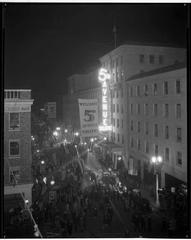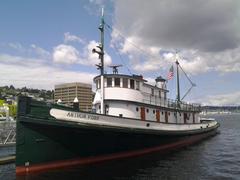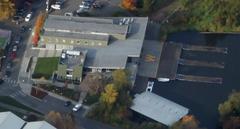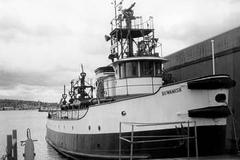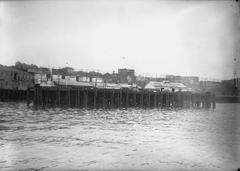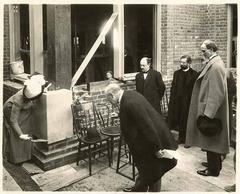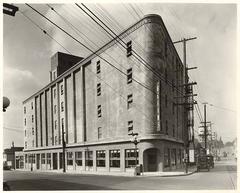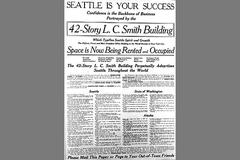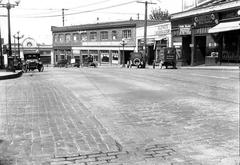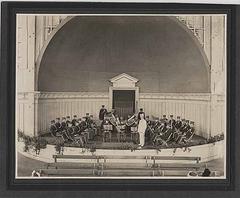Pioneer Square Totem Pole: Complete Guide to Visiting Hours, Tickets, and Seattle’s Historic Sites
Date: 03/07/2025
Introduction: The Pioneer Square Totem Pole and Its Significance
In the heart of Seattle’s oldest neighborhood, the Pioneer Square Totem Pole stands as both an artistic marvel and a focal point for conversations about Indigenous heritage, cultural appropriation, and civic identity. Originally carved around 1790 by Tlingit artists from Tongass Island, Alaska, the pole was created to honor Chief-of-All-Women, a prominent Tlingit matriarch. Its journey from Alaska to Seattle is marked by layers of history, controversy, and ongoing dialogue about representation and reconciliation.
Today, the totem pole is a key landmark in Pioneer Square Park, adjacent to the historic iron pergola and the bust of Chief Seattle. Accessible to all and free to visit, the site welcomes millions each year for self-guided exploration, guided tours, and cultural events. This guide offers an in-depth look at the totem pole’s origins, the circumstances surrounding its acquisition, guidance for respectful visitation, and recommendations for exploring Seattle’s broader historical landscape. (Burke Museum) (HistoryLink) (Quirky Travel Guy)
Table of Contents
- Introduction
- Historical Overview: Origins, Acquisition, and Controversy
- Artistic and Cultural Significance
- Restoration and Modern Reflections
- Visiting the Pioneer Square Totem Pole: Essential Information
- Visitor Etiquette & Cultural Sensitivity
- Frequently Asked Questions (FAQ)
- Summary & Travel Tips
- References & Useful Links
Historical Overview: Origins, Acquisition, and Controversy
Tlingit Heritage and Artistic Tradition
The Pioneer Square Totem Pole, sometimes referred to as the Seattle Totem Pole or Chief-of-All-Women Pole, originated with the Tlingit people of Tongass Island, Alaska. Carved from red cedar around 1790, the pole commemorated Chief-of-All-Women, a revered matriarchal figure, and exemplified the Tlingit’s matrilineal society and their narrative art (walkerzone.org). Totem poles in Tlingit tradition serve as visual records of clan lineage, mythology, and social status.
Acquisition and Cultural Appropriation
In 1899, a group of Seattle businessmen, under the sponsorship of the Seattle Post-Intelligencer, removed the original Tlingit pole from an unoccupied village near Fort Tongass, Alaska—without consent from its owners. They transported it to Seattle, cutting it in half to facilitate shipping, and erected it in Pioneer Square amid public celebration. The pole’s removal prompted outrage and legal action from the Tlingit community, who ultimately received only a token fine in restitution, while the pole remained in Seattle (Burke Museum) (High Country News). This episode is now widely acknowledged as an example of colonial-era cultural appropriation.
Local Context and Indigenous Representation
It is important to note that totem poles are not part of the Coast Salish artistic traditions native to the Seattle area, such as those of the Duwamish and Suquamish. The presence of a northern-style totem pole in Seattle often overshadows the stories and artistic expressions of local Indigenous peoples, raising concerns about cultural misrepresentation and erasure (Salish Current).
Artistic and Cultural Significance
The pole features classic Tlingit formline designs, depicting figures such as Raven (symbolizing creation), Bear (strength), and human clan ancestors. These motifs are deeply rooted in Tlingit cosmology and storytelling. The pole’s prominent placement in Pioneer Square quickly embedded it into Seattle’s civic identity, serving as a city emblem in promotional materials and inspiring the names of local institutions like the Seattle Totems hockey team (Wikipedia).
Restoration and Modern Reflections
Damage, Replica, and Restoration
In 1938, an arson fire severely damaged the original pole. It was subsequently returned to Alaska, and Tlingit master carver Charles Brown, alongside the Kyan and Kinninook families, created a replica from red cedar. This new pole was blessed and installed in 1940 during a potlatch ceremony, symbolizing resilience and a step toward redressing past injustices (Living New Deal). The replica was restored in 1972, and the site—including the pole, iron pergola, and Pioneer Building—was designated a National Historic Landmark in 1977.
Ongoing Dialogues and Calls for Change
The story of the Pioneer Square Totem Pole continues to spark debate. Recent years have brought renewed calls from Indigenous leaders and activists for its removal or reinterpretation, citing ongoing issues of cultural appropriation and the importance of honoring local Coast Salish traditions. Others see its presence as an opportunity for education about the entangled histories of Indigenous peoples and settlers in the Pacific Northwest (High Country News).
Visiting the Pioneer Square Totem Pole: Essential Information
Location & Accessibility
- Address: Pioneer Square Park, 600 1st Ave S, Seattle, WA 98104
- Setting: At the intersection of 1st Avenue and Yesler Way, adjacent to the historic iron pergola and Chief Seattle’s bust.
- Accessibility: The area is wheelchair accessible, with paved walkways and nearby accessible parking. Public transportation (bus and light rail) offers convenient access.
Visiting Hours & Admission
- Hours: The totem pole is outdoors and accessible 24 hours a day, year-round.
- Admission: Free; no tickets required.
Guided Tours & Events
- Multiple local tour companies and Indigenous-led groups offer walking tours that include the totem pole and Pioneer Square’s broader historical context. The Pioneer Square Alliance and Seattle Parks and Recreation provide details on upcoming events, special ceremonies, and storytelling sessions.
Photography Tips
- Best Light: Early morning or late afternoon for dramatic shadows and vibrant colors.
- Angles: Capture the pole with the iron pergola and historic architecture for compelling compositions. Always be respectful of other visitors and any ceremonial activities.
Nearby Attractions
- Klondike Gold Rush National Historical Park: Free museum chronicling Seattle’s role in the gold rush.
- Seattle Underground Tour: Guided tours of subterranean passageways revealing post-fire city history.
- Occidental Park: A lively gathering space with seasonal events.
- Smith Tower Observatory: Offers panoramic city views and historic exhibits.
- Art Walks & Galleries: The neighborhood hosts a monthly First Thursday art walk.
Visitor Etiquette & Cultural Sensitivity
- Respect the Site: Do not touch or climb the totem pole.
- Cultural Awareness: Read interpretive plaques and consider the context of the pole’s creation and acquisition.
- Photography: Permitted, but always be mindful of the pole’s significance.
- Support Indigenous Perspectives: When possible, choose Native-led tours or educational resources for the most accurate interpretation.
Frequently Asked Questions (FAQ)
Q: Are there any fees to visit the totem pole?
A: No, visiting the totem pole and Pioneer Square Park is free.
Q: Is the totem pole original?
A: The current pole is a 1940 replica carved by Tlingit artisans after the 1899 original was damaged by arson.
Q: Are guided tours available?
A: Yes, several local and Native-led tours include the pole as part of their itinerary.
Q: Is the site accessible for people with disabilities?
A: Yes, Pioneer Square Park is wheelchair accessible; note that some surrounding streets are cobblestone.
Q: Can I take photos?
A: Yes, but please be respectful and avoid disrupting ceremonies or events.
Summary & Travel Tips
The Pioneer Square Totem Pole encapsulates the intersection of Indigenous artistry, colonial history, and the ongoing quest for cultural justice. As a symbol of both Tlingit resilience and the complexities of Seattle’s past, it invites thoughtful engagement from every visitor. Enjoy free, year-round access, and enrich your experience by taking a guided tour, visiting nearby museums, or participating in local events. Use resources such as the Pioneer Square Alliance, Seattle Parks and Recreation, and the Audiala app for the latest updates and immersive guides.
Approach your visit with awareness and respect, and you’ll contribute to honoring the living histories and ongoing dialogues that make Pioneer Square a cornerstone of Seattle’s cultural landscape. (Salish Current) (High Country News) (Traveling with MJ)
References & Useful Links
- Pioneer Square Totem Pole: History, Visiting Hours, Tours & Seattle’s Iconic Landmark (walkerzone.org)
- Burke Museum: How Did Totem Poles Become a Symbol of Seattle?
- Pioneer Square Alliance: Iron Pergola & Tlingit Indian Totem
- Pioneer Square Totem Pole - Wikipedia
- Living New Deal: Pioneer Square Totem Pole, Seattle, WA
- Traveling with MJ: Seattle 10 Things to Do in Pioneer Square This Weekend
- HistoryLink: Pioneer Square Totem Pole
- Backside of America: Seattle Part IV Pioneer Square
- High Country News: Tribal Affairs: Activists Want to Remove Seattle’s Iconic Totem Poles
- Salish Current: Are Totem Poles Northwest Tradition or Cultural Invaders?
- Quirky Travel Guy: Things to Do Pioneer Square Seattle
- Secret Seattle: Things to Do in Pioneer Square
